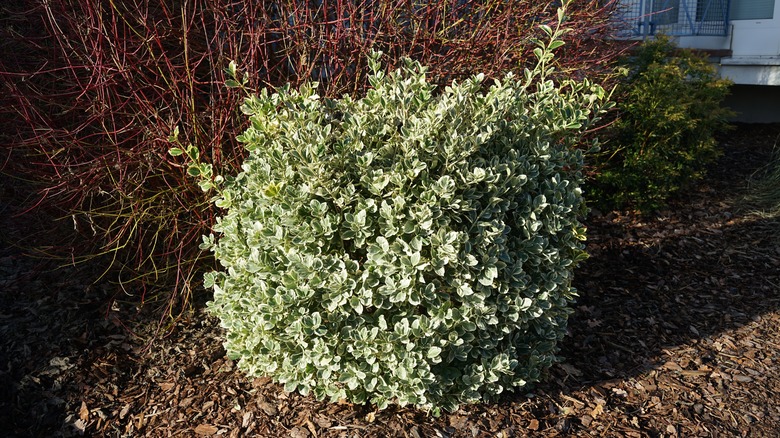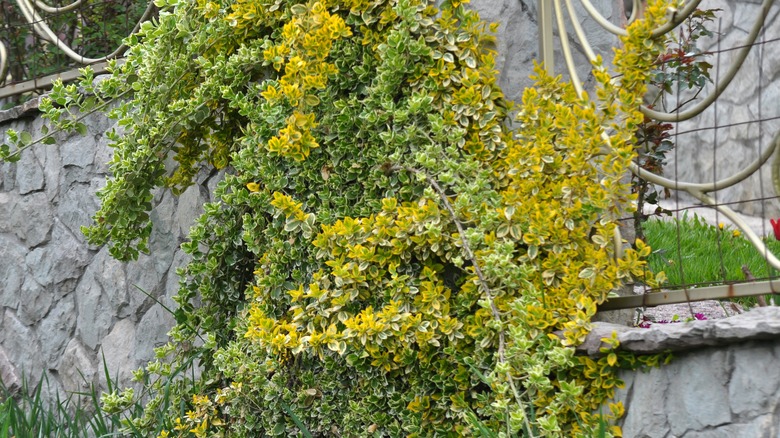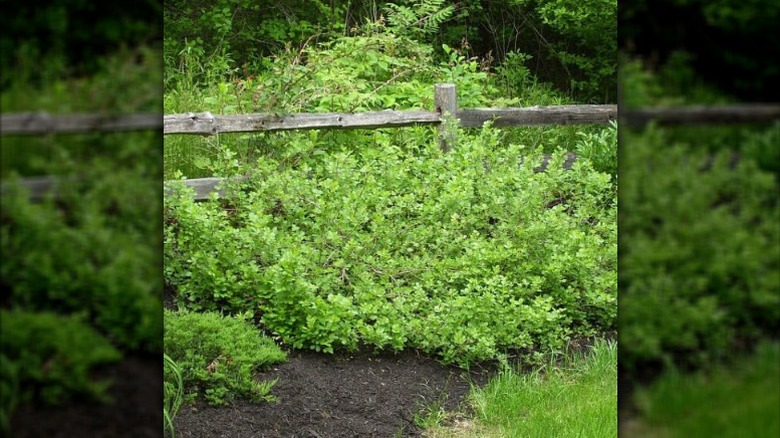The Downsides To Growing Wintercreeper (& A Better Alternative To Plant Instead)
Regret ever digging a hole in your garden bed for wintercreeper (Euonymus fortunei)? You're far from alone. Many unsuspecting gardeners have done the same, which is why wintercreeper now numbers among the invasive vines you should know about in the U.S. Its lime and forest green variegated foliage is deceptively pretty; it stands out at a nursery and was once promoted as an ornamental ground cover (despite it actually being a climber) for difficult growing conditions. Those who took wintercreeper home from the nursery quickly found out its downsides: The vine forms a thick blanket of foliage that shades out and subsequently kills anything underneath, will scale trees in no time, and takes a lot of work to get rid of once it's established. The solution, however, is simple: Replace your wintercreeper with a native plant instead, like fragrant sumac.
You may know wintercreeper as climbing, spreading, Japanese, creeping, and wintercreeper Euonymus, Fortune's spindle, or climbing spindle-tree. This bittersweet family (Celastraceae) vine is native to China, Japan, and Korea, and was introduced to the U.S. in 1907. Today, there are at least 30 cultivars. It's semi-evergreen, perennial, and grows extremely quickly in Hardiness Zones 5 to 9 — all attributes that have led to it being considered invasive in much of the eastern United States. Wintercreeper is a Tier 1 invasive species in Maryland and named invasive in Alexandria and Arlington, Virginia. It's labeled a noxious weed in the Midwest, and said to have invasive tendencies in Connecticut and Oregon. Sales of wintercreeper are prohibited in Indiana and regulated in New York. It's listed as a high invasion risk in northern, central, and southern Florida, and has taken over parks and backyards across Central Ohio.
What makes wintercreeper so dastardly for gardens?
Wintercreeper was once promoted as a climbing plant perfect for your north-facing wall because it grows as well in deep shade as it does in full sun. Likewise, it will happily put down roots in most soil types and does well in drought and neglected and urban areas. It only finds boggy conditions troublesome. However, wintercreeper's adaptive success often results in the demise of nearby plants. It steals sunlight, nutrients, and water from any plants growing nearby as it spreads outward across a garden bed, smothering them. Once a wintercreeper tendril gains purchase on the bark, the vine can quickly overwhelm and even kill shrubs and small trees. As a ground cover, it maxes out at about 12 inches tall, but give it a tree or pole to scale and it will grow to an astonishing 70 feet.
The plant spreads quickly via seed, which animals help disperse, and lateral shoots that take root where they touch the ground. You can try to manually pull the plant from the ground, but don't leave any roots behind, as they'll re-sprout. Chemical controls include applying a systemic herbicide to the cut stems of the plant or spraying the leaves with a triclopyr solution. Birds will eat wintercreeper's seed-packed fruit and deer the leaves, but, overall, wintercreeper has far less nutrient and lifecycle value to local wildlife than the native flora it rapidly displaces. Alarmingly for families with children who like to play in the garden, all parts of wintercreeper may be toxic when ingested. Expect various symptoms, from weakness to stomach upset to convulsions.
Grow native instead: Fragrant sumac is an ecosystem-boosting alternative to wintercreeper
Given all this, and coupled with wintercreeper's invasive status in many parts of the U.S., finding native alternatives is a must. Native shrub fragrant sumac (Rhus aromatica) is an often-recommended option. While it doesn't turn into a vine, it definitely rambles, with the branches putting out roots as they grow (though not invasively so) and forming a thicket. If you were growing wintercreeper as a bank stabilizer or to waterfall over a retaining wall, plant fragrant sumac instead. Like its imported counterpart, fragrant sumac grows in almost any soil type, including poor soils, and tolerates growing in partial shade.
The fragrant sumac cultivar Rhus aromatica 'Gro-Low' is ideal for groundcover; where Rhus aromatica reaches 6 feet tall, this smaller species grows to just 3 feet, though it will quickly colonize an area of up to 8 feet around. Both varieties boast teeny yellow flowers and berries that, similarly to wintergreen's fruit, will attract birds to your yard for fun feathered sightings (and other wildlife). Townsend's Solitaires love the fruit, and the red-banded hairstreak butterfly will lay its eggs on the species. The plants grow in USDA Hardiness Zones 3 to 9, thriving in temperatures slightly lower than wintercreeper, but match it at the top end of the range. If you love the fact that purple-leaved wintercreeper (Euonymus fortunei 'Coloratus') foliage changes hue during the colder months, you'll love the fall color of fragrant sumac. Mackay Nursery Company sells a 9-inch bare root 'Gro-Low' sumac sapling for about $24. Get a trial-size pack of Rhus aromatica (fragrant sumac) seeds for $8 from MySeeds.Co.


